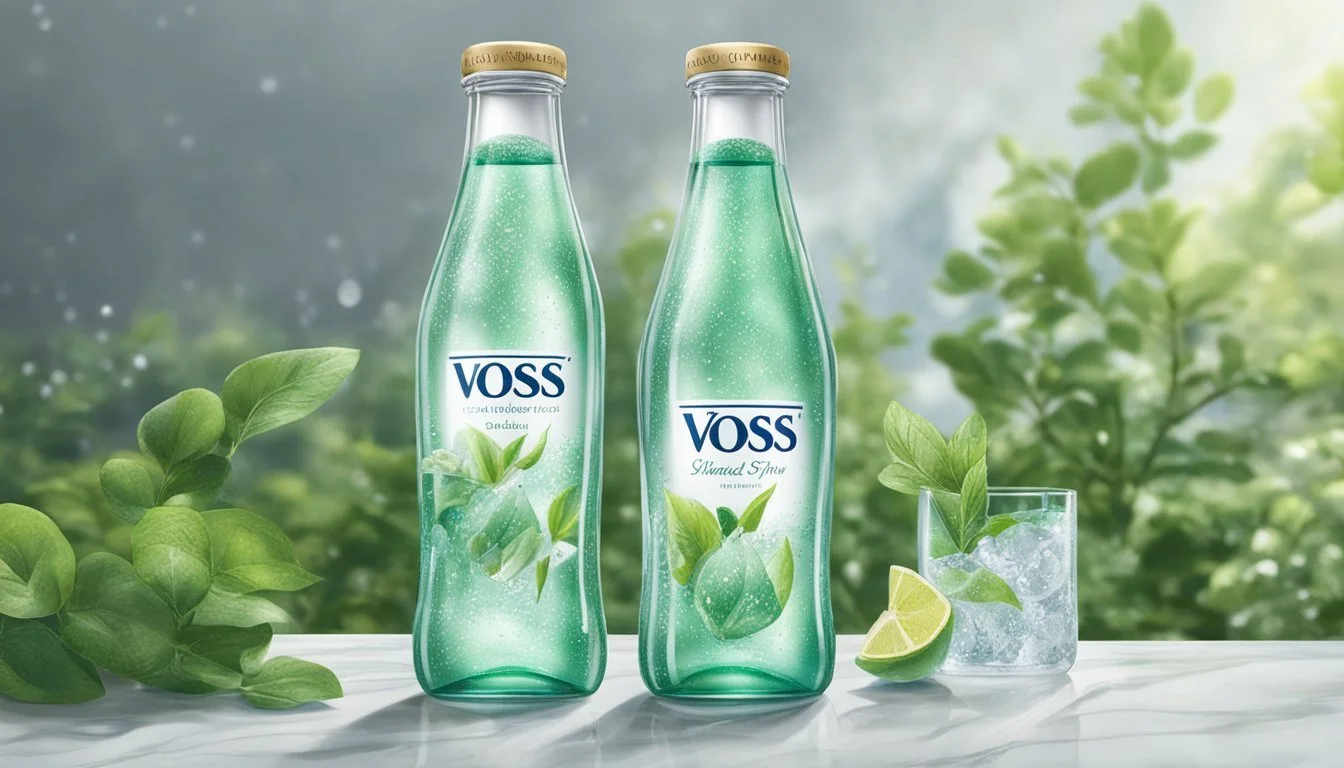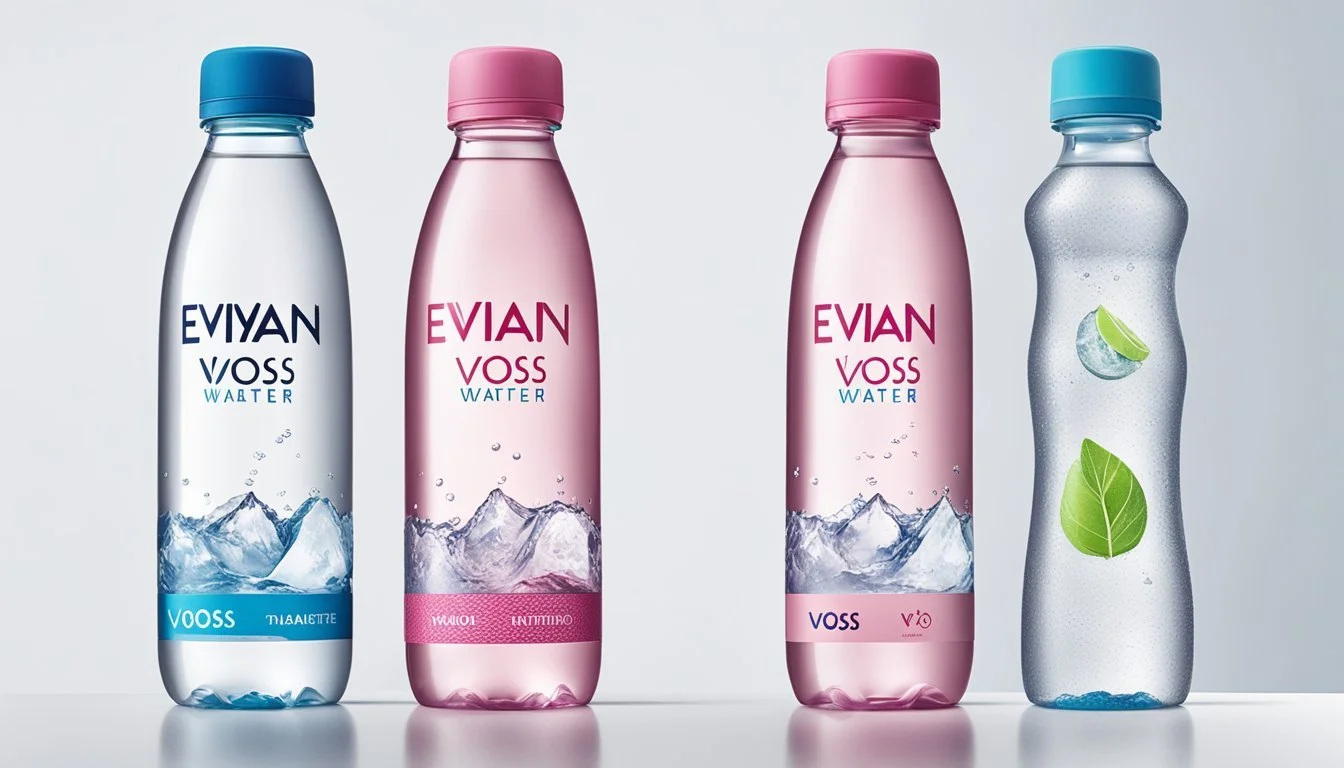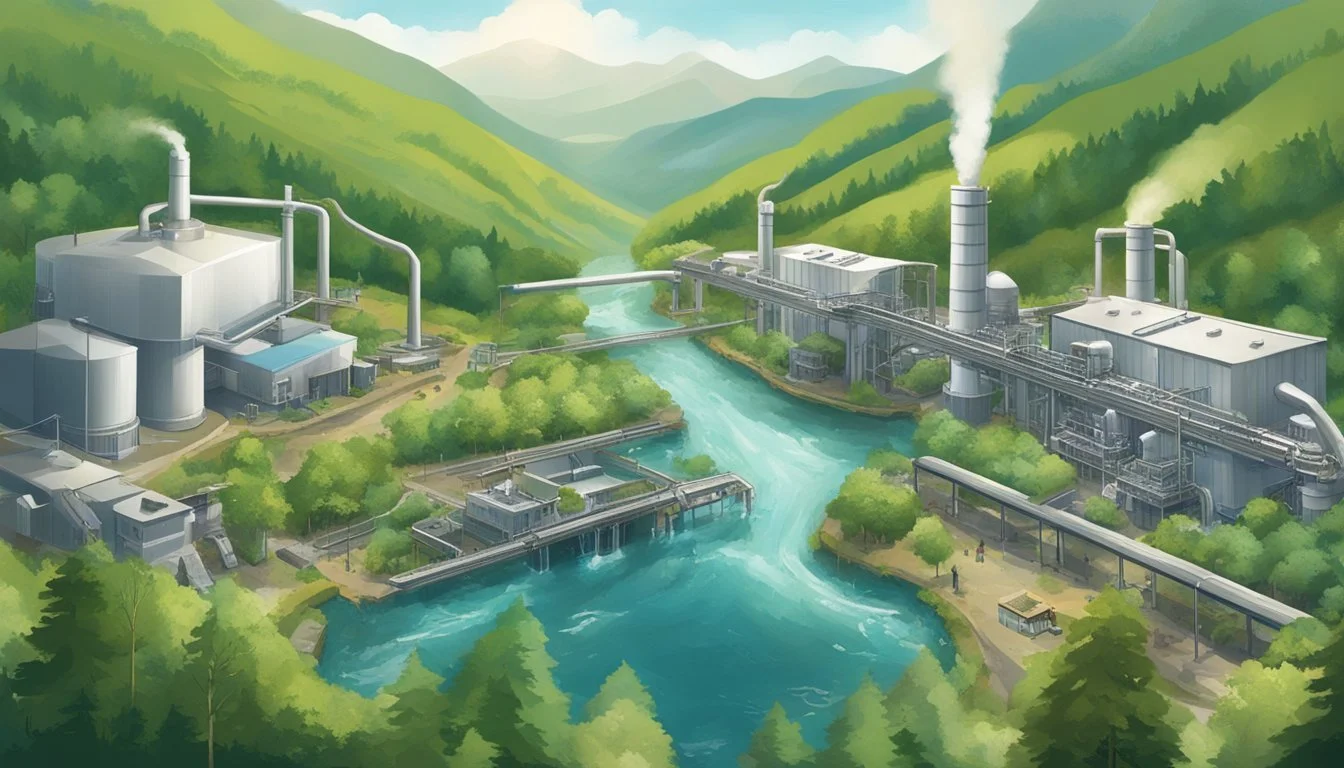Evian vs. Voss
Unveiling the Superior Bottled Water Brand
In the realm of premium bottled waters, Evian and Voss have emerged as leading brands, each commanding a significant following due to their unique source and branding proposition. Evian water originates from the French Alps and is touted for its natural filtration process, which takes over 15 years as the water trickles down through glacial sand, endowing it with a balanced mineral composition. On the other hand, Voss, sourced from the pristine aquifers of Norway, is often recognized for its distinctively pure taste and stylish cylindrical bottles, making it a favorite not only for hydration but also as a lifestyle accessory among the fashion-conscious.
Consumers often find themselves debating between Evian and Voss when considering bottled water that offers both quality and taste. While both brands are synonymous with a luxurious hydration experience, they appeal to different sensibilities with their respective narratives. Evian's commitment to environmental sustainability and natural processes has carved a niche among those who prioritize eco-conscious consumption. Voss, with its minimalistic design and clear taste profile, appeals to those seeking sophistication in both aesthetics and palate.
Choosing between Evian and Voss is not simply a matter of taste preference, but a reflection of one's values and lifestyle. The decision between these two brands encompasses factors such as the sourcing of the water, the mineral content, the bottling process, and the brand's environmental impact. These aspects are paramount for discerning consumers who seek to align their choices in bottled water with their personal standards for quality, health, and luxury.
Origins and Sources of Bottled Water
Evaluating bottled water like Evian and Voss involves tracing their journeys from deep within the earth to the bottle. Each brand's reputation is built on the purity and unique mineral composition derived from their respective sources.
Mountain Springs and Aquifers
Evian natural spring water originates from the pristine French Alps, where it is sourced directly from the Cachat Spring near the town of Évian-les-Bains. The water emerges naturally filtered through glacial sand that is packed with enriching minerals over a 15-year journey. In contrast, Voss water is sourced from a confined, underground aquifer in Norway, where it's protected from the air and other pollutants, ensuring its purity before being bottled at a low mineral content.
Artificial Purification and Filtration Processes
While Evian and Voss rely heavily on nature for filtration, many bottled waters undergo artificial purification and filtration processes. These processes can include a combination of micron filtration, reverse osmosis, and ozonation to achieve desired purity levels. However, it is the natural filtration process, not artificially implemented ones, that contributes to the distinction of both Evian and Voss.
Differences Between Mineral, Spring, and Purified Water
Mineral Water: Sourced from a mineral-rich spring or well, such as Evian, where the water absorbs minerals, including magnesium and calcium, from the surrounding rocks.
Spring Water: Comes from an underground formation from which water flows naturally to the earth's surface, like Evian, which is then bottled at the source.
Purified Water: Has been processed to remove chemicals and contaminants. This category does not typically apply to naturally sourced waters like Evian or Voss, as they contain naturally occurring minerals and are free from most contaminants found in municipal water sources.
Chemical Composition and Health Benefits
The chemical composition of bottled water significantly influences its health benefits. Key factors include pH levels, overall alkalinity, and the presence of essential minerals and electrolytes.
pH Levels and Alkalinity
Evian water typically has a pH level of around 7.2, which means it is slightly alkaline. Alkaline waters have a pH above 7 and are often sought after for their potential health benefits, such as neutralizing acid in the bloodstream. Voss water's pH level tends to be neutral, sitting close to a pH of 7, which aligns with the pH of pure water.
Minerals and Electrolytes
Minerals and Electrolytes in Evian and Voss Water:
Mineral/Electrolyte Evian Voss Calcium Present Lower levels Magnesium Present Lower levels Bicarbonate Present Not highlighted Electrolytes Balanced mix Balanced mix
Evian is known for its rich mineral content, which includes calcium important for bone health and magnesium which is crucial for muscle contraction and blood pressure regulation. On the other hand, Voss contains lower levels of these minerals but still offers a balanced mix of electrolytes essential for hydration and various bodily functions.
Brand Comparison: Evian vs Voss
In the world of premium bottled waters, Evian and Voss have established themselves as leading brands. They sparkle in the market due to their unique sources and mineral content, but how do they truly compare?
Evian: Natural Minerals from the French Alps
Evian water begins its journey as rain and snow that falls on the pristine peaks of the French Alps. Over a period of 15 years, this precipitation naturally filters through glacial sand, which enriches the water with a unique blend of minerals. The final product, bottled at the source in Évian-les-Bains, offers a distinct taste that reflects its alpine origin.
Key Minerals: Calcium, magnesium, potassium, silica
Source: The French Alps
TDS (Total Dissolved Solids): 345 parts per million
With a neutral pH of 7.2, Evian water not only provides essential minerals but also boasts a balance in terms of acidity and alkalinity, making it a smooth and refreshing choice for many.
Voss: Purity from Norwegian Aquifers
Voss prides itself on the purity and minimalistic mineral content of its water. Sourced from an underground aquifer in Norway, the protection from external elements ensures Voss offers one of the purest water possible. The low mineral content water is noted for its clean taste and is cherished for its exceptional quality.
Key Feature: Low TDS, exceptionally pure
Source: Norwegian aquifer
TDS: 44 parts per million
Voss water, with its iconic cylindrical bottle, has become synonymous with luxury and exclusiveness. The brand's commitment to maintaining the natural purity of their product has earned it a dedicated following.
Taste and Flavor Profile
Evian and Voss water both provide distinct flavor profiles that cater to various palates. Evian's water is characterized by its smooth taste, with subtle mineral notes derived from its source in the French Alps. It tends to have a balanced mineral content that contributes to a taste described by some as refreshing and clean. The natural filtration process through glacial sands enriches Evian with electrolytes and minerals, subtly influencing its flavor.
In contrast, Voss water, sourced from an aquifer in Norway, offers a crisp and pure experience with a notably low mineral content. This results in a flavor that is often perceived as neat and unadorned, making it stand out from other brands.
Water Brand Flavor Characteristics Evian Balanced, smooth, mineral-rich Voss Crisp, clean, low-mineral
The flavor profile of bottled water is an outcome of its total dissolved solids (TDS), which accounts for its taste and mouthfeel. Evian water's flavor is slightly influenced by its moderate TDS level, whereas Voss water's low TDS level results in a more neutral flavor.
Water taste is subjective, and the preference for either Evian or Voss may depend on one's taste buds. Both brands offer premium waters that go through stringent purification processes ensuring quality and safety. Consumers choosing between the two will notice subtle distinctions, where Evian offers a feel of the Alps' unique terroir, and Voss delivers a minimalist taste that echoes the purity of Norwegian aquifers.
Packaging and Environmental Impact
In the comparison of Evian and Voss, a significant aspect to consider is how each brand approaches packaging and its consequent environmental impact.
Plastic Bottles vs. Glass and Alternative Packaging
Evian primarily uses plastic bottles for its water, focusing on recyclability with a commitment that all of its bottles will be made from 100% recycled plastic by 2025. Voss, on the other hand, offers its water in both plastic and glass bottles, with glass being a more eco-friendly option due to its infinite recyclability. Despite this, plastic bottles still represent a substantial environmental concern due to their lower recycling rates and higher possibility of ending up in landfills. Some brands have explored boxed water as an alternative, which boasts better recyclability and a lower carbon footprint during transportation due to its shape and lighter weight.
Sustainability Practices and Carbon Footprint
Both Evian and Voss have engaged in efforts to become more sustainable and reduce their carbon footprint. Evian has secured a carbon neutral certification for its global business and production sites, reducing carbon emissions through initiatives such as renewable energy usage. Voss has also shown a commitment to sustainability, leaning on its responsible sourcing and efficient production processes. However, it's important to note that the environmental impact of bottled water remains high when compared to tap water, with large amounts of CO2 released during the production of bottled water. The choice of packaging and the distance from source to consumer are significant contributing factors to a brand's overall environmental footprint.
Market Presence and Consumer Preferences
In the realm of high-end bottled water, brands like Evian and VOSS have carved distinct market positions. Consumer preferences often hinge on accessibility and brand reputation, which influence market presence.
Availability and Convenience
Evian and VOSS are global brands, thus widely available across different retail platforms. Consumers can find these bottled waters in varied locations, from high-end hospitality venues to standard supermarkets. Major retailers like Walmart and Amazon ensure these products are just a few clicks or a short walk away.
Amazon: Broad online presence with options for bulk buying and subscription services.
Walmart: Physical and online shelves stocked with both brands, offering easy access for in-person and online shoppers.
The convenience factor plays a significant role in shaping demand for any bottled water brand. The ease with which consumers can find and purchase their preferred water directly correlates with a brand's market influence.
Popular Brands and Market Influence
Both Evian and VOSS have established themselves as popular brands within the bottled water industry. Their market reach is global, thanks to the recognition of their quality and a successful marketing approach.
Evian:
Owned by Danone, a multinational corporation with a strong market influence.
Recognized for its natural spring water and environmental initiatives.
VOSS:
Known for its iconic cylindrical bottle and premium positioning in the market.
Markets itself on purity and sustainability efforts, appealing to eco-conscious consumers.
Market Influence of Other Brands:
Coca-Cola and PepsiCo are dominant players in the beverage industry with bottled waters like Dasani and Aquafina respectively.
Nestlé boasts a diverse portfolio of water brands, including Poland Spring and Perrier, reinforcing its market presence.
The market presence of a bottled water brand is often a reflection of consumer preferences driven by brand perception, quality, and the impact of parent companies such as Danone, Coca-Cola, and Nestlé.
Health Concerns and Safety Standards
When considering the health aspects and safety standards of bottled water, consumers should be aware of the regulatory frameworks that govern water quality and packaging materials, specifically how these aspects are addressed by different agencies and the implications for consumption.
Regulations and Testing: EPA vs. FDA
EPA and FDA regulations play critical roles in ensuring the safety of bottled water. The Environmental Protection Agency (EPA) is responsible for setting safety standards for tap water, whereas the Food and Drug Administration (FDA) regulates bottled water. This creates a dual system where the FDA benchmarks its bottled water standards in alignment with EPA's tap water regulations.
EPA:
Sets quality standards for tap water.
Regulates the presence of contaminants under the Safe Drinking Water Act.
FDA:
Oversees bottled water as a food product.
Requires regular testing for quality and safety according to specific criteria.
BPA Content and Potential Risks
Bisphenol A (BPA) content in plastic bottles is a concern due to its potential health risks. BPA can leach into water over time, especially when bottles are exposed to heat, posing risks to consumers.
The FDA has set BPA limits to ensure that the levels do not pose a substantial risk to health.
Both Evian and Voss adhere to packaging safety standards to minimize BPA contamination in bottled water.
Brand Packaging BPA Policy Evian Plastic and Glass Options BPA-free plastics and glass Voss Plastic and Glass Options BPA-free plastics and glass
Both brands offer options for consumers to avoid BPA exposure, indicating that the companies are attentive to the potential risks and committed to maintaining regulatory compliance.
The Debate: Bottled Water vs. Tap Water
When determining a preference between bottled water and tap water, consumers weigh in various factors such as purity, taste, cost, and environmental impact. Bottled water, often perceived as being cleaner and more refined, comes in various brands with differing sources and filtration methods. For example, Evian is sourced from springs, while Voss is bottled in Norway with minimal treatment, highlighting the natural minerals and pH levels inherent to its source.
Tap water, typically sourced from municipal reservoirs, undergoes rigorous filtration and quality tests to meet specific safety standards. It is easily accessible and cost-effective, with the added benefit of fluoride for dental health. However, the quality of tap water can vary depending on one's locality, and the presence of infrastructure such as old pipes might affect the water's taste and safety.
Comparison Table:
Feature Bottled Water Tap Water Source Natural springs; aquifers; purified municipal sources Municipal sources; wells; lakes and reservoirs Filtration Brand-specific methods; often highlights mineral content Standardized processes; may include chlorination, fluoridation pH Levels Varied, often alkaline Controled, typically neutral Cost Higher, due to packaging and branding Lower, subsidized by local governments Environmental Impact Higher, due to plastic bottle use and transportation Lower, with nominal packaging waste
This comparison underscores that preferences for bottled water or tap water may differ based on individual concerns for health, convenience, and the environment. Each option has distinct benefits regarding filtration and pH balance, with bottled water often being embraced for its minerality and purported health benefits, while tap water is appreciated for its sustainability and economic advantages.







